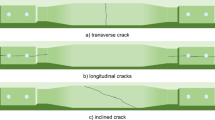The present study is devoted to the problem of damage localization by means of data classification. The commercial ANSYS finite-elements program was used to make a model of a cantilevered composite plate equipped with numerous strain sensors. The plate was divided into zones, and, for data classification purposes, each of them housed several points to which a point mass of magnitude 5 and 10% of plate mass was applied. At each of these points, a numerical modal analysis was performed, from which the first few natural frequencies and strain readings were extracted. The strain data for every point were the input for a classification procedure involving k nearest neighbors and decision trees. The classification model was trained and optimized by finetuning the key parameters of both algorithms. Finally, two new query points were simulated and subjected to a classification in terms of assigning a label to one of the zones of the plate, thus localizing these points. Damage localization results were compared for both algorithms and were found to be in good agreement with the actual application positions of point load.







Similar content being viewed by others
References
R. Jegadeeshwaran and V. Sugumaran, “Comparative study of decision tree classifier and best first tree classifier for fault diagnosis of automobile hydraulic brake system using statistical features,” Measurement, 46, 3247-3260 (2013).
M. Elangovan, S. Babu Devasenapati, N.R. Sakthivel, and K.I. Ramachandran, “Evaluation of expert system for condition monitoring of a single point cutting tool using principle component analysis and decision tree algorithm,” Expert Syst. Appl., 38, 4450-4459 (2011).
V. Muralidharan and V. Sugumaran, “Feature extraction using wavelets and classification through decision tree algorithm for fault diagnosis of mono-block centrifugal pump,” Measurement, 46, 353-359 (2013).
P. Baraldi, F. Cannarile, F. Di Maio, and E. Zio, “Hierarchical k-nearest neighbours classification and binary differential evolution for fault diagnostics of automotive bearings operating under variable conditions,” Eng. Appl. Artif. Intel., 56, 1-13 (2016).
R. Casimir, E. Boutleux, G. Clerc, and A. Yahoui, “The use of features selection and nearest neighbors rule for faults diagnostic in induction motors,” Eng. Appl. Artif. Intel., 19, No. 2, 169-177 (2006).
J. Vitola, F. Pozo, D. A. Tibaduiza, and M. Anaya, “A sensor data fusion system based on k-nearest neighbor pattern classification for structural health monitoring applications,” Sensors, 17, 417-443 (2017).
J. Vitola, F. Pozo, D. A. Tibaduiza, and M. Anaya, “Distributed piezoelectric sensor system for damage identification in structures subjected to temperature changes,” Sensors, 17, 1252-1278 (2017).
N. Mechbal, J. S. Uribe, and M. Rébillat, “A probabilistic multi-class classifier for structural health monitoring,” Mech. Syst. Signal Pr., 60-61, 106-123 (2015).
I. H. Witten, E. Frank, and M. A. Hall, Data Mining: Practical Machine Learning Tools and Techniques, Third edition, Morgan Kaufmann Publishers (2011).
https://uk.mathworks.com/help/stats/classificationensemble.resubloss.html
https://uk.mathworks.com/help/stats/classification-using-nearest-neighbors.html#bsehylk
L. Rokach and O. Maimon, Data Mining with Decision Trees: Theory and Applications, Second edition, World Scientific (2015).
Acknowledgements
The research leading to these results has received funding from the Latvia State Research Program under the grant agreement “Innovative Materials and Smart Technologies for Environmental Safety, IMATEH.”
Author information
Authors and Affiliations
Corresponding author
Additional information
Russian translation published in Mekhanika Kompozitnykh Materialov, Vol. 53, No. 6, pp. 1043-1058, November-Decemer, 2017.
Rights and permissions
About this article
Cite this article
Janeliukstis, R., Ruchevskis, S. & Chate, A. Classification Model for Damage Localization in a Plate Structure. Mech Compos Mater 53, 725–736 (2018). https://doi.org/10.1007/s11029-018-9698-8
Received:
Published:
Issue Date:
DOI: https://doi.org/10.1007/s11029-018-9698-8




